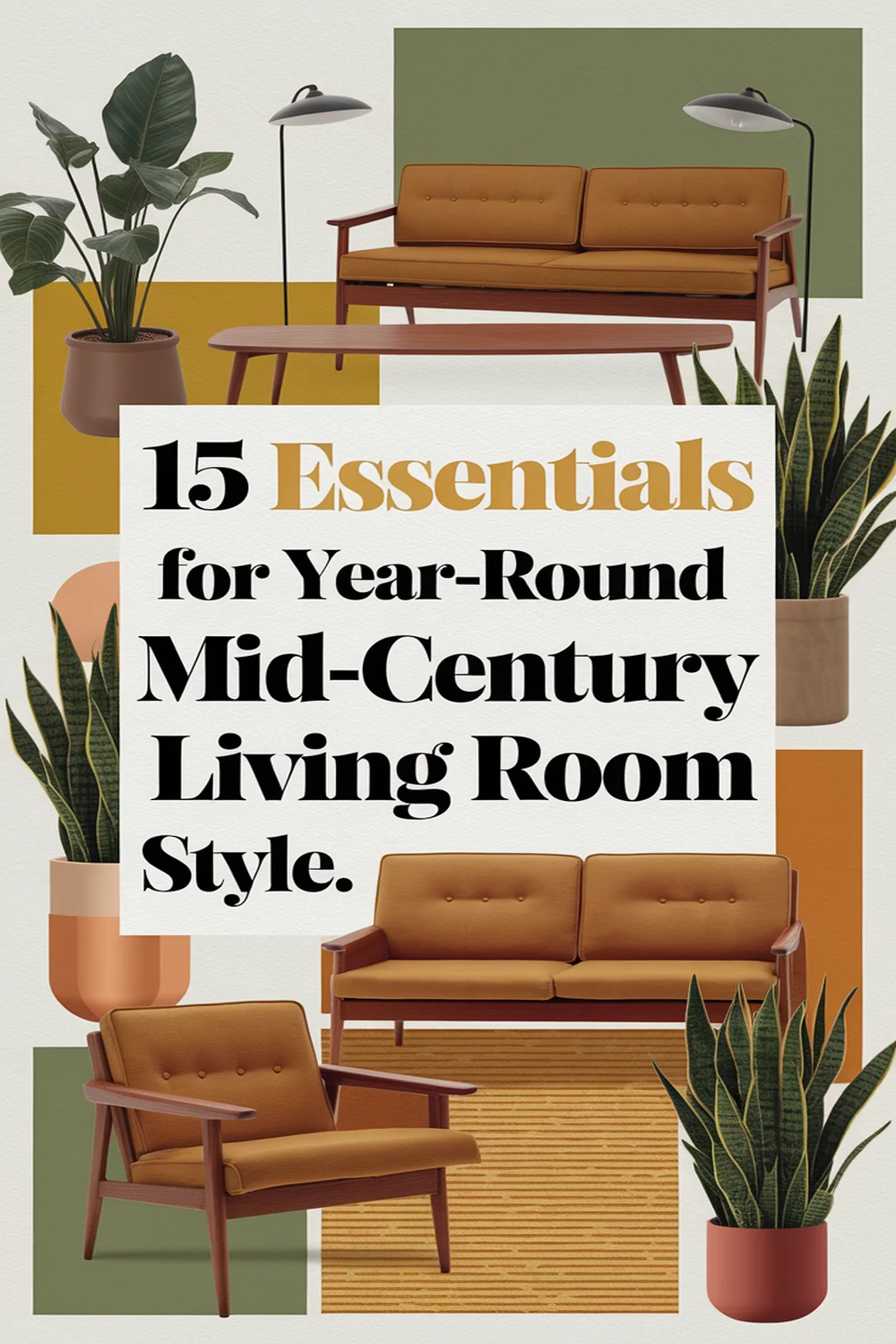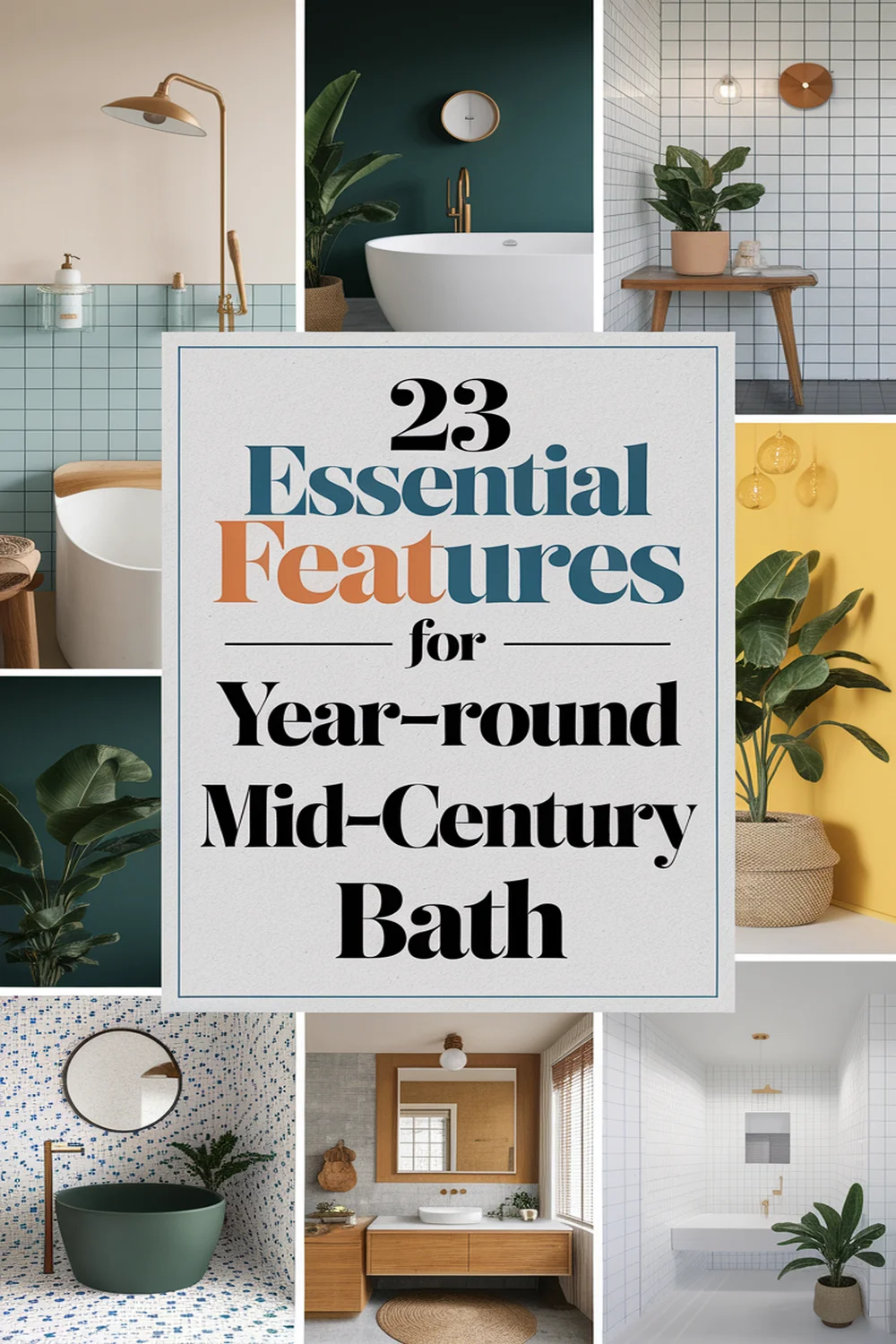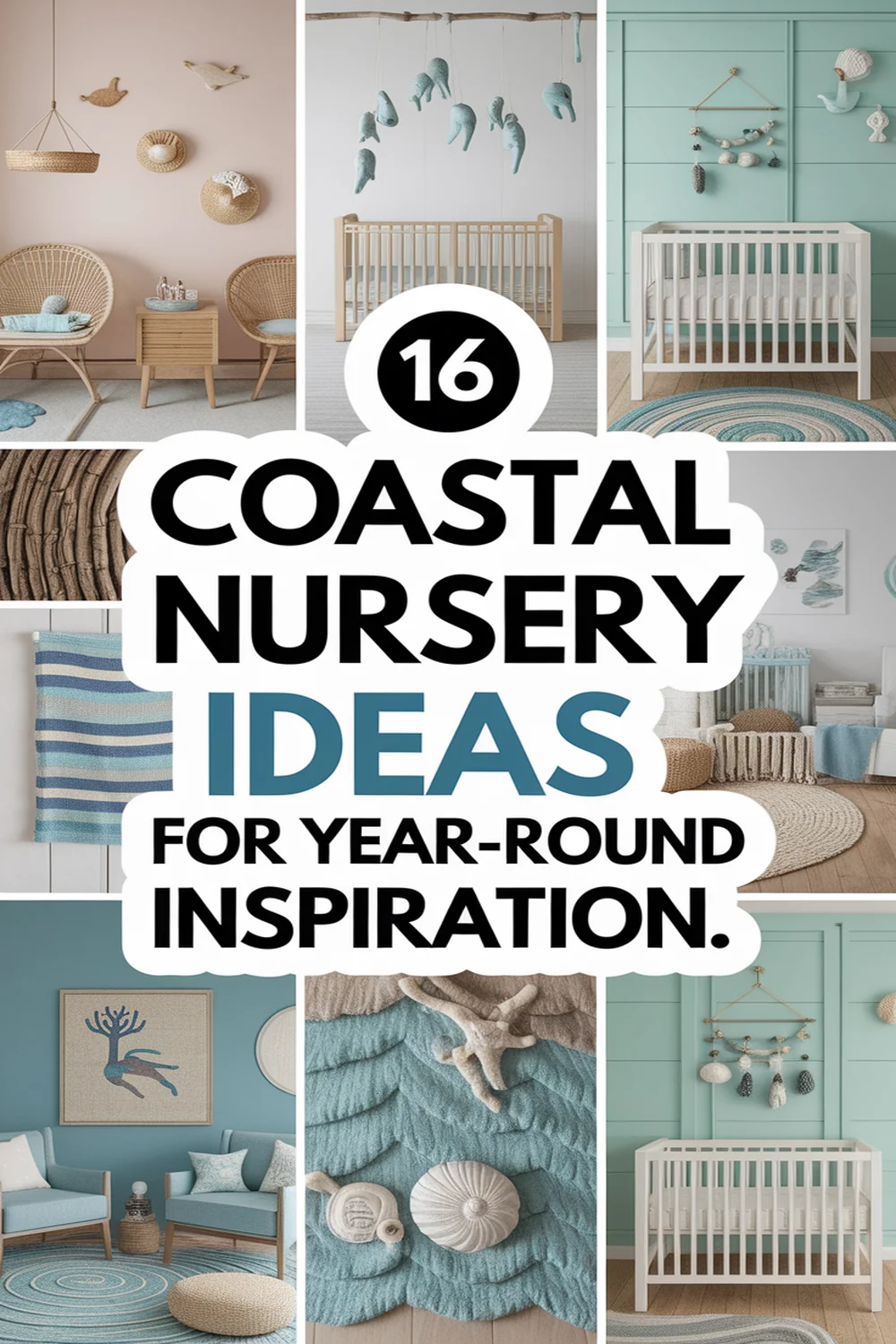This post may contain affiliate links. Please read our policy page.
In a year-round minimalist library style, I focus on neutral color palettes that create calm spaces and open layouts that encourage exploration. I choose functional furniture like modular seating and adjustable shelving to maximize utility. Natural light from large windows enhances the inviting atmosphere, while versatile lighting solutions cater to diverse needs. Streamlined book displays and regular organization guarantee accessibility. By integrating technology and sustainable practices, I foster a space that supports community connection. Discovering these elements will enhance your understanding.
Emphasis on Neutral Color Palettes
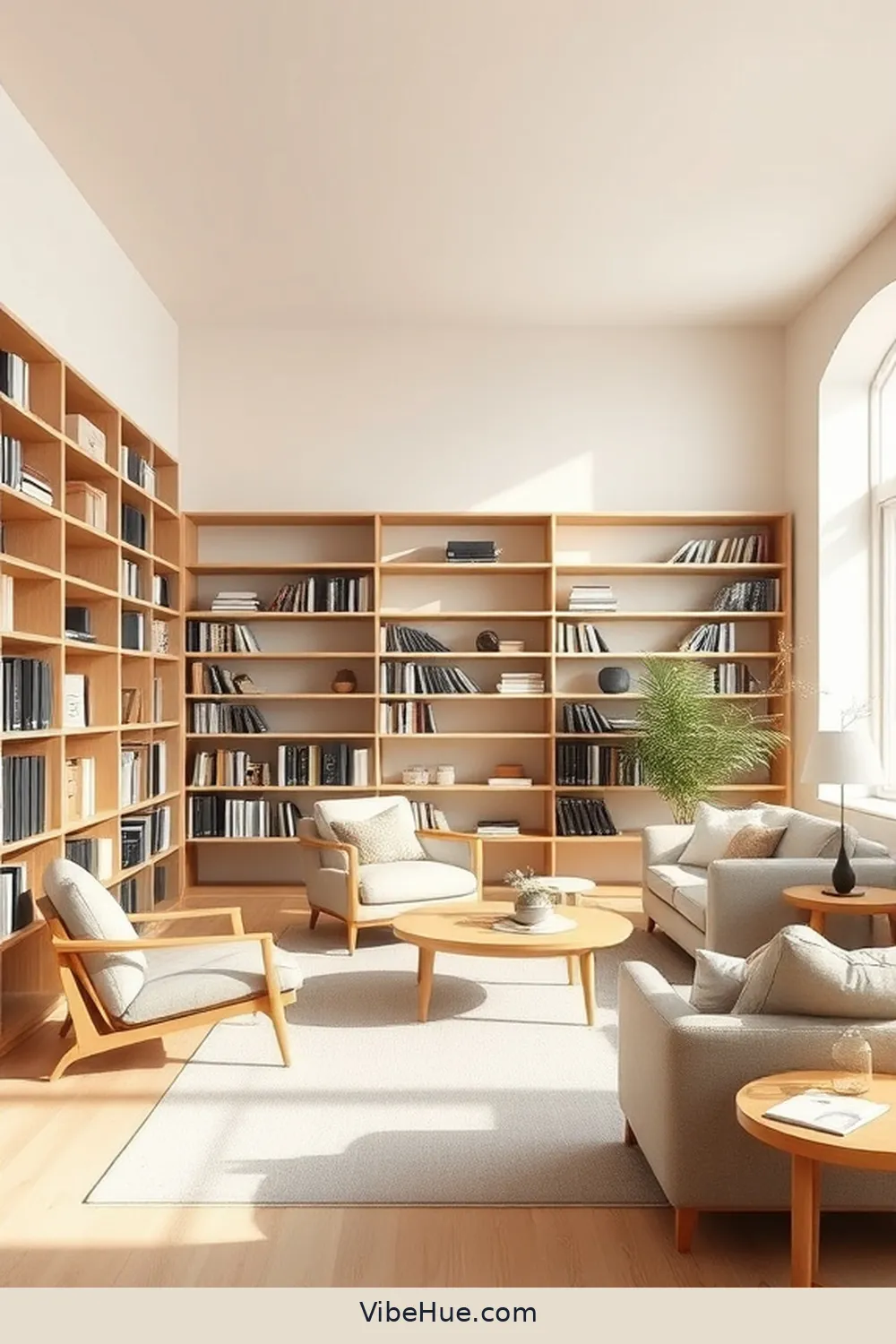
When designing a minimalist library, I often find that an emphasis on neutral color palettes sets the perfect foundation for the space. Soft whites, beiges, and gentle grays create an inviting atmosphere that encourages focus and tranquility.
These hues foster a sense of calm, allowing the books and furnishings to take center stage. Additionally, neutral colors enhance natural light, making the space feel larger and more open.
They also provide versatility, complementing various materials such as wood, metal, or stone, which can be strategically incorporated throughout the design. By carefully selecting shades that promote warmth and serenity, I guarantee the library remains functional yet aesthetically pleasing.
Ultimately, a neutral palette is essential for achieving the timeless appeal inherent in minimalist design.
Recommended Items
Discover our handpicked products and tools to help you create the perfect minimalist library—explore and enjoy!
Open and Airy Layout
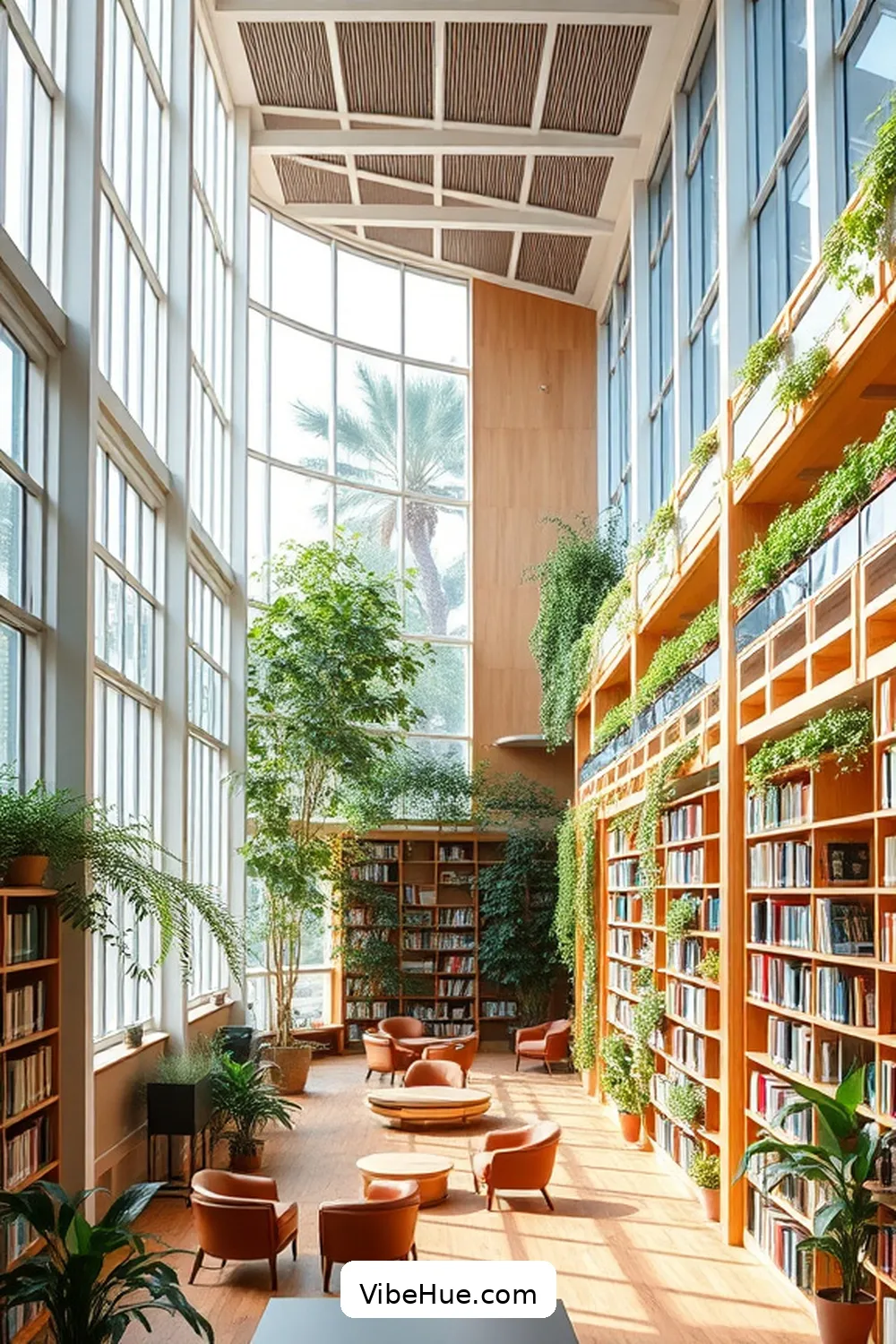
A well-considered layout can profoundly impact the usability and aesthetic of a minimalist library. An open and airy design fosters a sense of freedom and encourages exploration.
When arranging bookcases and seating, I prioritize wide pathways and unobstructed sightlines, allowing patrons to feel connected to the space. Natural light plays a vital role; large windows or strategically placed skylights can enhance the bright, open atmosphere.
I also suggest incorporating indoor plants to soften edges without cluttering the area, promoting tranquility. Balance is key—ensuring that essential areas, like reading nooks and study zones, are easy to navigate.
Ultimately, an open layout creates a harmonious environment, inviting readers to immerse themselves in literature amidst an uncluttered backdrop.
Functional Furniture Choices
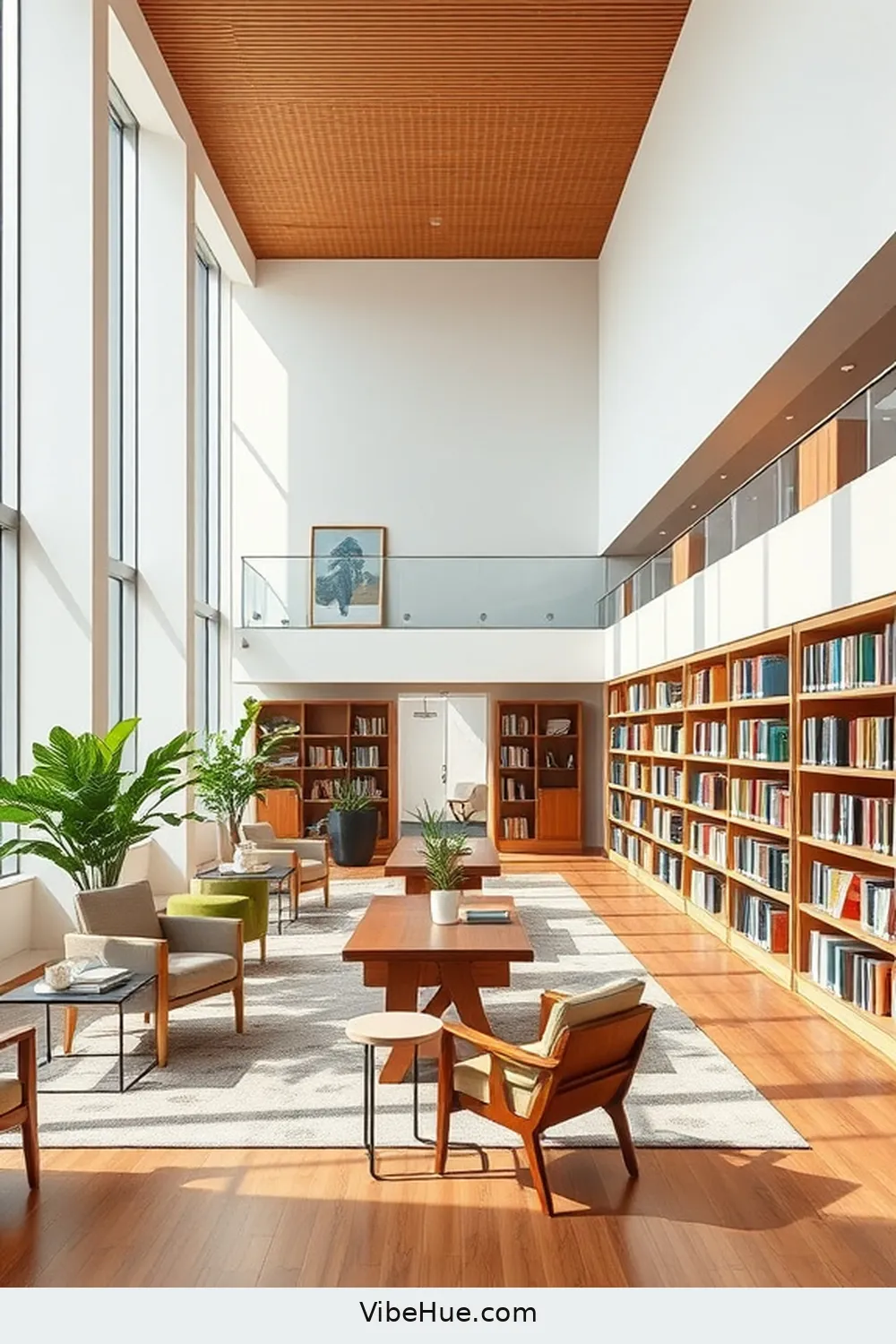
Choosing the right furniture can markedly enhance the functionality of a minimalist library, especially since it directly influences how patrons interact with the space.
I prioritize multi-functional pieces, such as modular seating that can be rearranged for various activities. Selecting tables with built-in storage helps minimize clutter while providing adequate work surfaces.
Additionally, I often incorporate adjustable shelving units, allowing flexibility for diverse collections and community events. Lightweight chairs make it easy for patrons to maneuver and create collaborative environments.
It’s essential that every piece serves a purpose, ensuring optimal space utilization. By making thoughtful furniture choices, I cultivate an inviting atmosphere that encourages exploration and learning, ultimately fostering a sense of community within the minimalist framework.
Step-by-Step Guide to Minimalist Library Decor
Streamlined Book Display

While considering the arrangement of books in a minimalist library, I find that a streamlined book display markedly enhances not just accessibility but also the overall aesthetic of the space.
By categorizing books both by genre and size, I create a coherent visual flow that invites exploration. I prefer open shelving over traditional cabinets; this choice eliminates barriers, allowing for easy access and a sense of openness.
Categorizing books by genre and size fosters a visually inviting space, encouraging exploration through open shelving that enhances accessibility.
Additionally, I limit duplicate titles and prioritize keeping only the most essential works visible. This approach not only reduces clutter but also highlights the beauty of each volume.
A minimalist arrangement encourages a thoughtful interaction with the books, making the library not just a storage space but a curated, inviting environment.
Natural Light Utilization

Incorporating natural light into a minimalist library design amplifies both functionality and ambiance. I find that large windows and strategically placed skylights create an inviting space that not only reduces reliance on artificial lighting but also fosters a connection with the outdoors.
Utilizing light-colored walls and reflective surfaces can further enhance illumination, ensuring the library feels airy and expansive. Additionally, thoughtful placement of reading areas can take full advantage of daylight, improving user experience while reducing energy costs.
It’s essential, however, to contemplate shading solutions to prevent glare and overheating, thereby maintaining comfort. Ultimately, embracing natural light in a minimalist library nurtures both an engaging atmosphere and sustainable practices, making the space more resilient and enjoyable for all.
Textured Materials for Warmth
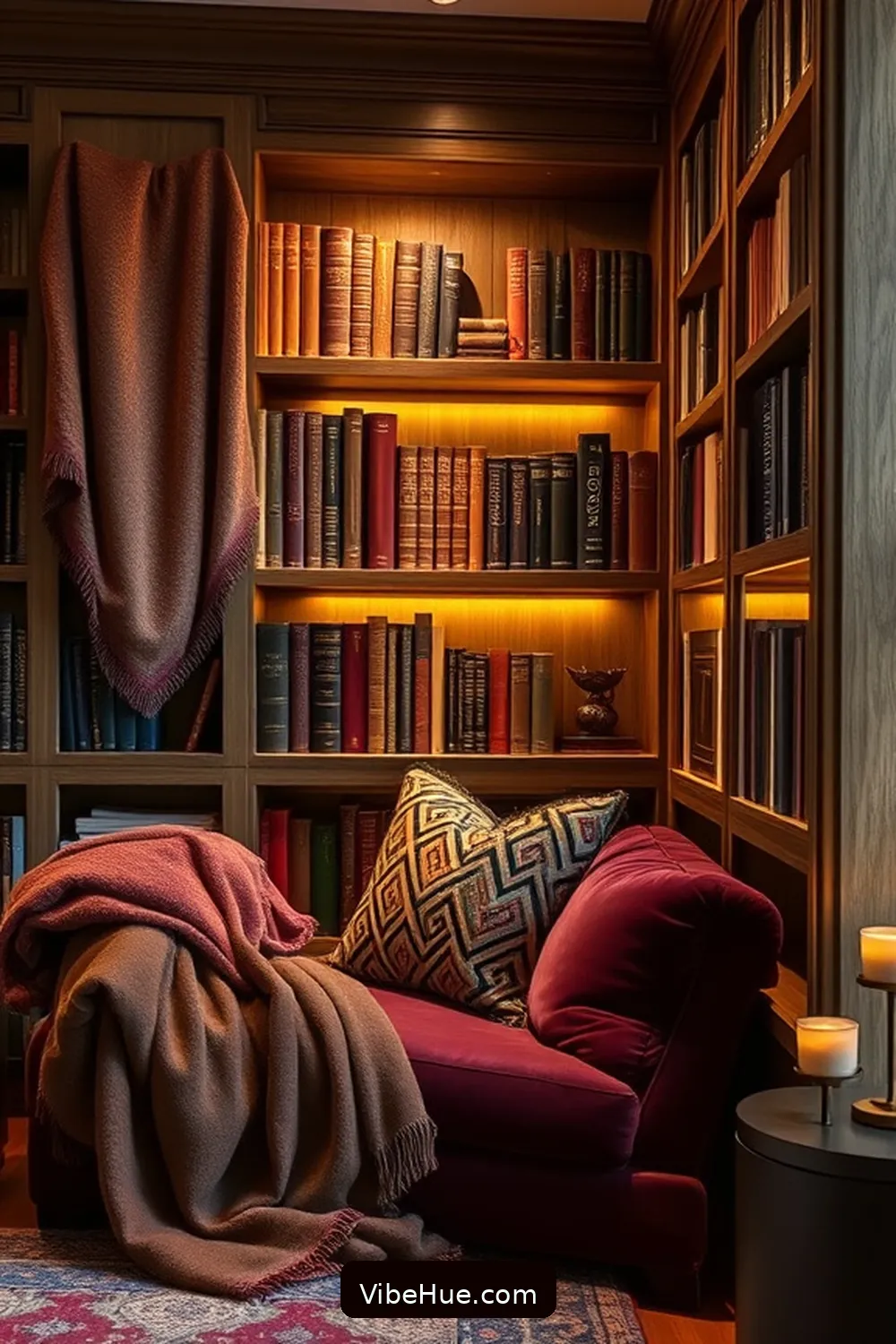
To create a warm and inviting atmosphere in a minimalist library, I prioritize the use of textured materials that add depth and character to the design. Natural fibers like wool and cotton soften the starkness often associated with minimalist spaces. Incorporating wooden elements—whether through shelving or furniture—adds warmth and a tactile experience.
I also explore stone accents, such as slate tabletops, which introduce a grounding effect. In addition, mix fabrics like linen for cushions or throws, enhancing comfort while maintaining a clean aesthetic. These textures not only create visual interest but subtly invite users to engage with the space.
Minimal Decorative Elements

Although minimalism often emphasizes simplicity, I believe that the careful selection of minimal decorative elements can considerably enhance a library’s character. Instead of overwhelming the space, these elements can subtly evoke a sense of warmth and intrigue.
I often choose a few carefully curated items, like an abstract sculpture or a unique vase, that reflect my personal taste yet maintain simplicity. Artworks should be limited and intentionally placed, allowing them to create focal points without cluttering the room.
Additionally, incorporating natural elements, like plants in clean-lined pots, brings life to the space while keeping with a minimalist aesthetic. Ultimately, these elements create a harmonious balance that enriches the library experience without detracting from its core purpose.
Strategic Use of Negative Space
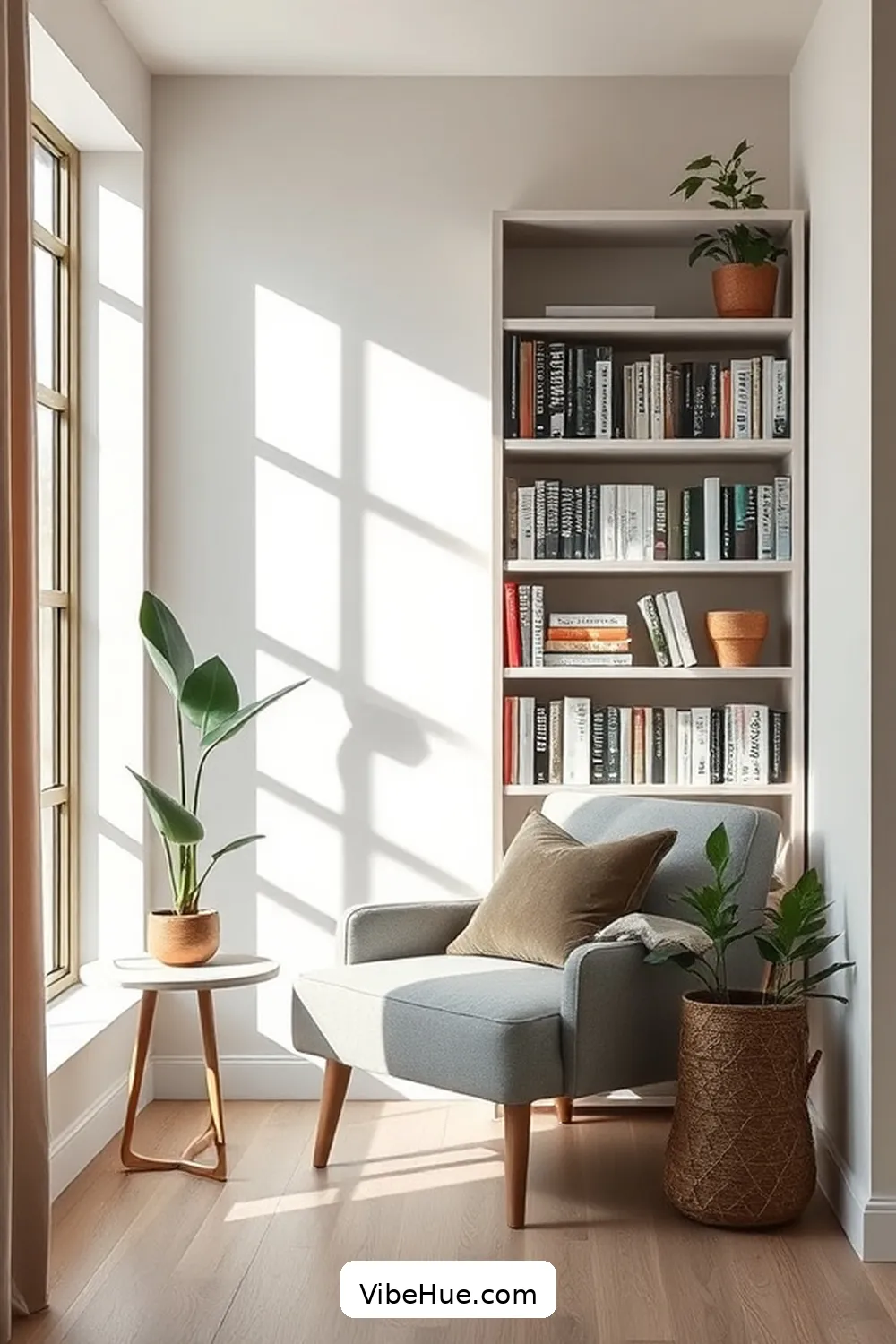
Negative space, when harnessed effectively, can greatly enhance the overall design of a minimalist library. It’s not just about what you include, but also what you leave out. This intentional use of blank areas encourages focus and helps create a serene atmosphere. By allowing the eye to rest, negative space invites contemplation and enhances the enjoyment of the space.
Here’s a quick comparison table to help illustrate its importance:
| Element | With Negative Space | Without Negative Space |
|---|---|---|
| Visual Focus | Clear focus on items | Cluttered, unfocused |
| Atmosphere | Calming environment | Overwhelming feel |
| Accessibility | Easier navigation | Confusing pathways |
| Engagement | Invites deeper thought | Distracts from purpose |
Utilizing negative space is an essential strategy for achieving minimalism.
Personalized Touches With Care
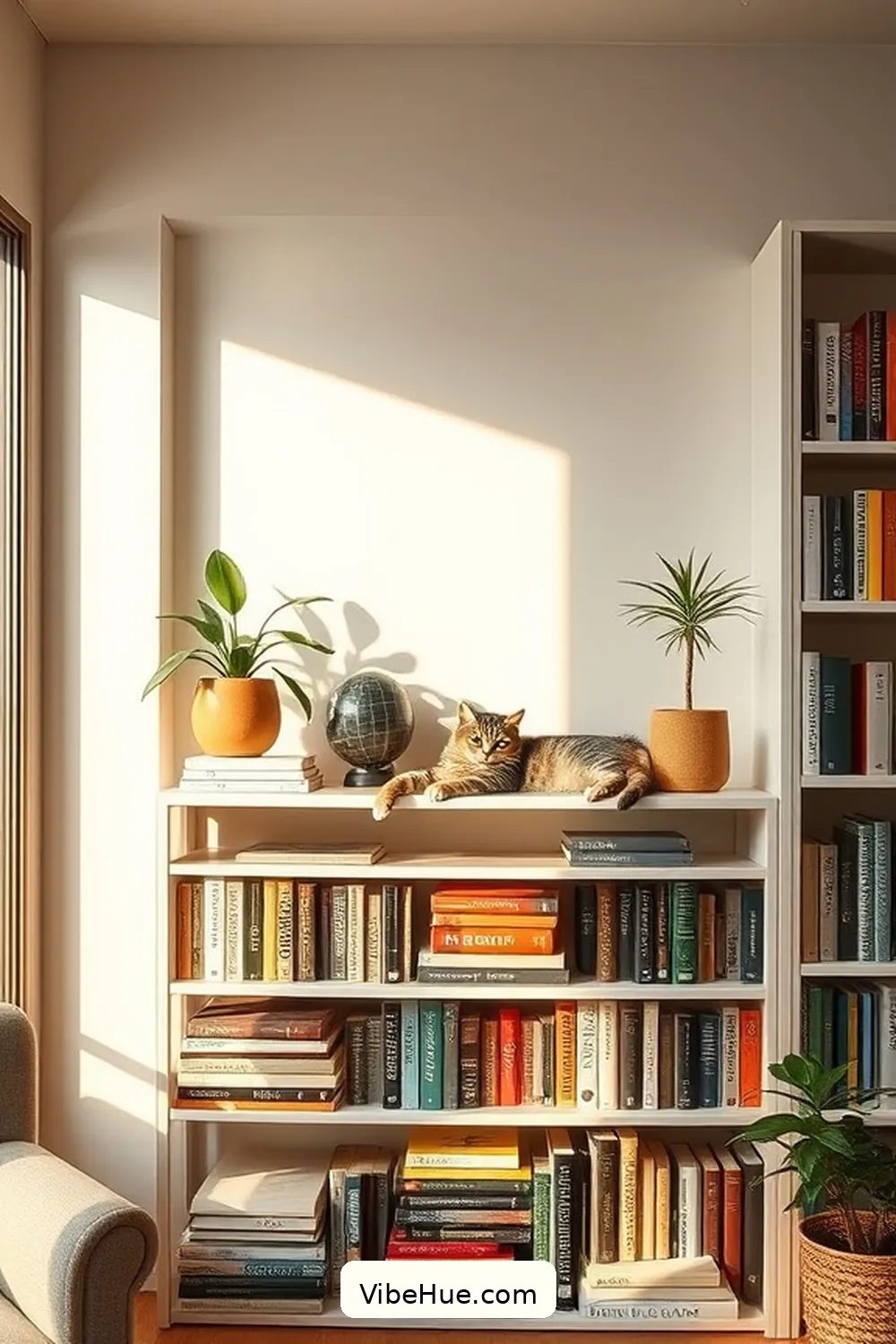
While crafting a minimalist library, I find that adding personalized touches can greatly elevate the space.
It’s crucial to create an environment that reflects your individuality while maintaining simplicity. Here are a few ideas I’ve found effective:
- Personalized bookends that reflect your interests or hobbies
- Artwork featuring local artists or self-portraits
- A cozy reading nook with a unique chair or vintage throw
- Custom shelving to showcase your favorite titles or memorabilia
- Handcrafted bookmarks that tell a story or evoke cherished memories
These elements form a harmonious blend of minimalism and personal flair, enhancing not just the aesthetics, but also the emotional connection we develop with our libraries.
Sustainable Design Practices

As I explore the domain of minimalist library design, it’s important to recognize the impact of sustainable practices on both the environment and our personal spaces.
Choosing eco-friendly materials, like reclaimed wood or recycled metals, sets a responsible foundation for your library. Implementing energy-efficient heating and cooling systems not only reduces your carbon footprint but also lowers utility costs.
Utilizing non-toxic paints and finishes improves indoor air quality, creating a healthier environment for reading and reflection. Consider incorporating plants to enhance aesthetics while supporting indoor air purification.
By embracing these sustainable design practices, I guarantee my minimalist library remains not just a haven of knowledge but also a reflection of my commitment to environmental stewardship.
Let’s create spaces that respect our planet while nurturing our minds.
Versatile Lighting Solutions

Effective lighting is essential for any minimalist library, as it not only influences the mood but also enhances functionality.
I’ve found that thoughtful lighting solutions allow for a seamless shift between different activities. Here are five versatile options that work well:
- Natural Light: Maximizing windows provides warmth and an inviting atmosphere.
- LED Track Lighting: Adjustable fixtures can highlight specific areas, perfect for reading or studying.
- Floor and Table Lamps: Flexible lighting that can be moved according to need boosts comfort.
- Dimmable Fixtures: Control intensity for tasks requiring focus or relaxation.
- Smart Lighting: Automated systems that adjust based on time or preference bring efficiency.
Regular Organization and Maintenance
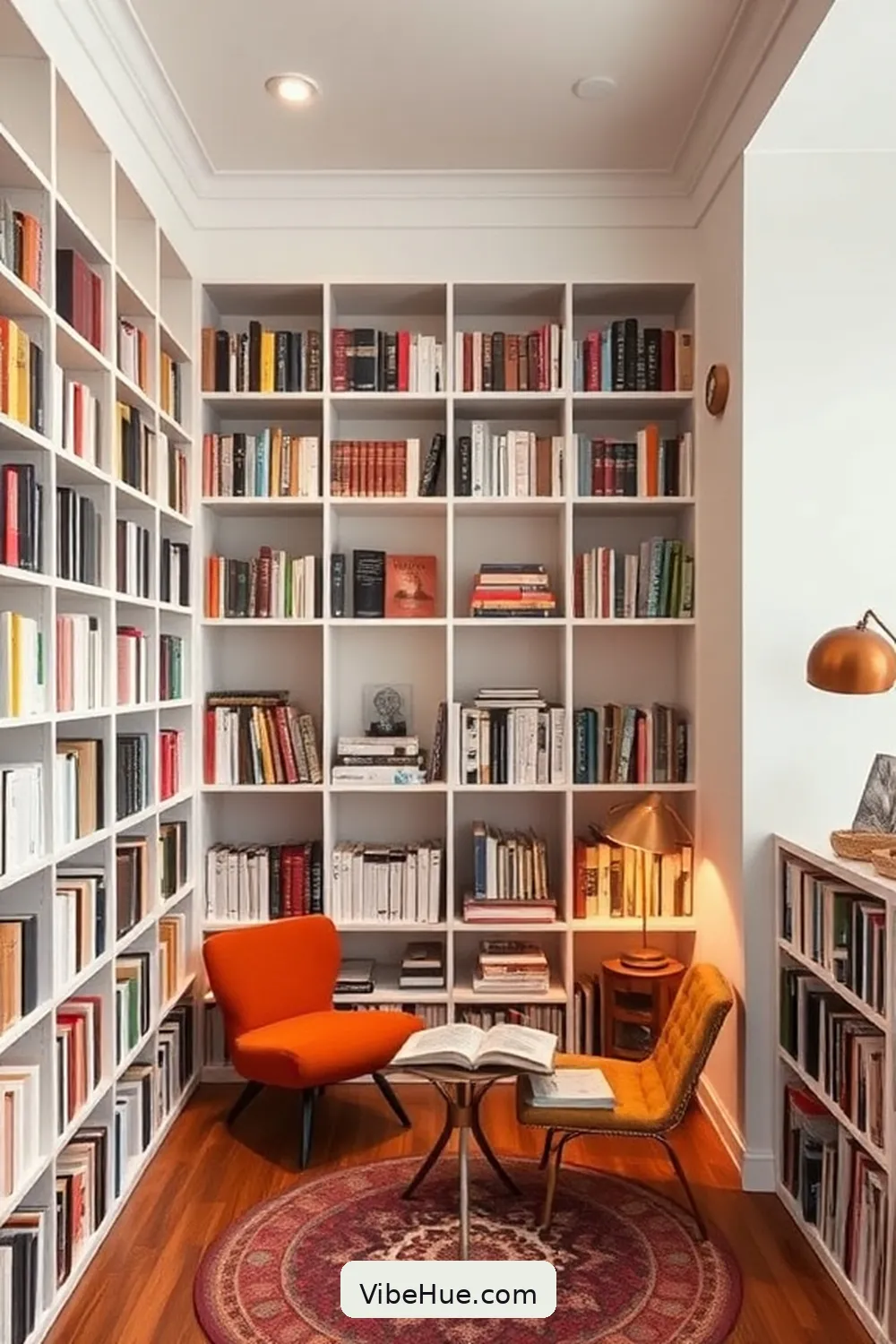
Maintaining a minimalist library requires regular organization to foster an inviting and functional space.
I’ve found that establishing a routine helps me keep my library in top shape. Start by evaluating your collection; consider what you truly need and what can be donated or stored away. I set aside time each month to categorize and shelve books, ensuring that everything has a designated place.
Dusting surfaces and decluttering areas reduces distractions and enhances the aesthetic appeal of my space. Additionally, I keep a dedicated list for any maintenance tasks—like repairing damaged books or updating labels.
Regular organization not only streamlines accessibility but also provides the satisfaction of a well-curated environment conducive to reading and studying.
Integration of Technology Seamlessly

Creating a minimalist library goes hand-in-hand with integrating technology seamlessly into the space. By thoughtfully incorporating tech, I’ve enhanced functionality while keeping aesthetic simplicity.
Here are five ways I achieve this integration:
- E-readers and Tablets: Offer access to a vast array of digital books without cluttering shelves.
- Smart Lighting: Adjusts based on natural light, creating an inviting atmosphere conducive to reading.
- Digital Cataloging Systems: Streamline organization, allowing for quick access to materials.
- Wi-Fi Connectivity: Guarantees easy access to online resources and research tools.
- Charging Stations: Provide convenient power sources without sacrificing design cohesion.
Embracing these technologies allows for a minimalist yet engaging library experience, enhancing both form and function.




